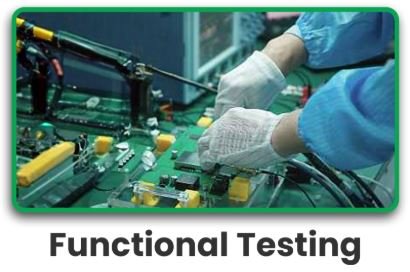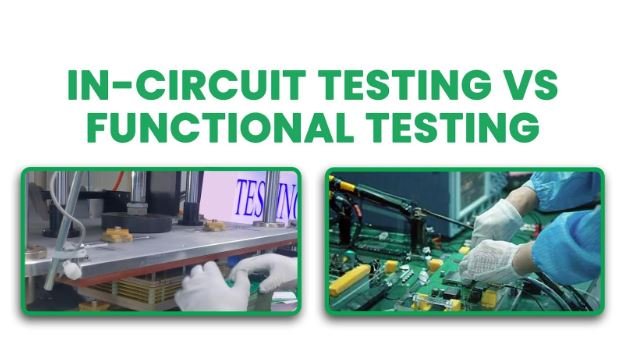In-Circuit Testing vs Functional Testing
Once a PCB fabrication & PCB assembly is completed, quality and reliability testing are performed to ensure the final product’s functionality. Numerous methods are used for testing, two of the most popular being In-Circuit Testing and Functional Testing.
Though both of these testing methods are used to achieve quality control, their results, outputs, and mechanisms are different.
Understanding the differences between these methods allows manufacturers to select which one better fits their requirements. In this blog, we will discuss the merits and demerits of ICT and FCT and what scenarios they can be used for.
This blog will provide insights into the effects each of these testing methods has on the final PCB prototype and assembly’s performance and reliability.
From an experienced PCB engineer to a novice in the field, everyone will be able to comprehend which testing mechanism meets their needs and how reducing testing costs will increase product quality.

In-Circuit Testing (ICT):
Purpose: The ICT is used to look for breakages such as open connections, shorts, misaligned components, and incorrect component values on the PCB during circuit and component testing.
How it works: During the ICT, a custom “bed of nails” fixture is utilized to test various parameters of each board component by applying electrical signals to it and measuring its resistance and capacitance.
Pros:
– Manufacturing defects can be located quickly and accurately
– The chance of assembling the parts on non-functional / X-Outs circuits gets low.
– It is suitable for mass production.
Cons
The need for unique test fixtures implies that these tests come with a significant initial cost.
It does not examine the PCB in actual operating conditions, which limits its scope.
Functional Testing (FCT):
Purpose: It functions by testing the PCB as a part of the final product in a box build assembly but in controlled alternative conditions.
How Does It Work: A test fixture is applied that shows output readings, such as the assembly’s temperature, voltage, or frequency, allowing it to serve its purpose and also could be an indication on testing equipment with green/red leads.

-It allows do attempt of the final product to a detailed examination of the operative capacity and operating nature.
-The product is able to function in real-life conditions while being assembled, supporting the desired output considered by product designers.
Cons:
-Requires custom testing equipment to support high-end technology, which can be difficult to procure.
-It is a bit more costly due to the complexity of dealing with and ordering custom test fixtures, but the savings in time make it worth the cost.
Benefits and Application
Using Either ICT or FCT along with the correct testing method has plenty of benefits. Utilization of the correct testing strategy has its share of benefits. Using one or the other has some abnormalities on the testing side that should not hamper overall operation.
In-circuit testing (ICT)
It aids in the detection of manufacturing anomalies like shorts or open connections. Therefore, it reduces the chances of the final product having flaws by enabling each element to be assembled appropriately. It is most beneficial in mass production when speed and accuracy in servicing are major requirements or concerns.
Functional Testing (FCT)
It is highly valuable in conditions where the board is of great use, and diagnostic functionalities are critical, such as consumer electronics, automotive testing, and medical emitters. It inspects whether the complete system is functional and ready to be used by checking whether all the parameters regarding a working system were met.
Expert Insights
“The integration of In-Circuit Testing (ICT) and Functional Testing (FCT) has evolved to meet the demands of modern PCB assembly”. Modular circuit designers offer flexibility and scalability by allowing subsystems like the ICT module and the FCT module to be upgraded or replaced independently. This is useful for adapting to different testing requirements or technological advancements.
On the other hand, unified testing platforms consolidate both ICT and FCT capabilities into a single hardware/software framework. This approach simplifies configuration and operation, making it easier to manage the testing process. However, it may limit flexibility and expandability compared to modular architectures.
A hybrid approach combines the best of both worlds, offering both the flexibility of modular designs and the integration of unified systems. This balance ensures both scalability and streamlined testing operations.
Frequently Asked Questions
Which is better, functional testing or performance testing?
Both are important and better. Performance testing measures a PCB’s specific electrical characteristics which is also called as E-Testing (after fabrication is done), while functional testing evaluates its overall performance under real-world conditions which also called as Bootup Testing (after pcb assembly) Functional testing is usually more comprehensive and useful for confirming a product’s functionality.
What are the advantages of using in-circuit testing?
In circuit test is also known as ICT / NET List testing. The accuracy and speed of in-circuit testing can also detect assembly or manufacturing errors, such as shorts, open connections, or missing nets or stubs. The core advantage of running ICT test before PCB Manufacturing is that it allows to give surety to a manufacturer that there are no Nets shorting with guaranteed to be correctly routed and assembled without the application of power shorts so that the components will not be damaged.
What is a functional circuit test?
FCT Functional Test is used to check the electric parameters and specifications of the device. It checks the electrical parameters and specifications of a PCB assembly by functioning the device in a normal environment where the assembly is expected to work.
What are the 7 types of PCB testing methods?
- In-Circuit Testing (ICT)
- Functional Testing (FCT)
- Flying Probe Testing
- Automated Optical Inspection (AOI)
- X-Ray Inspection
- Boundary Scan Testing
- Burn-In Testing
Conclusion
Both In-Circuit Testing and Functional Testing complement each other in terms of ensuring the quality and reliability of PCB assemblies. While ICT is suitable only for identifying defects, FCT, on the other hand, assesses the overall functional capability of a PCB when placed in real-life scenarios.
This is important because if manufacturers can effectively utilize all the pros and cons of each method, they will ultimately reduce the cost of the testing while improving the quality of the product.


